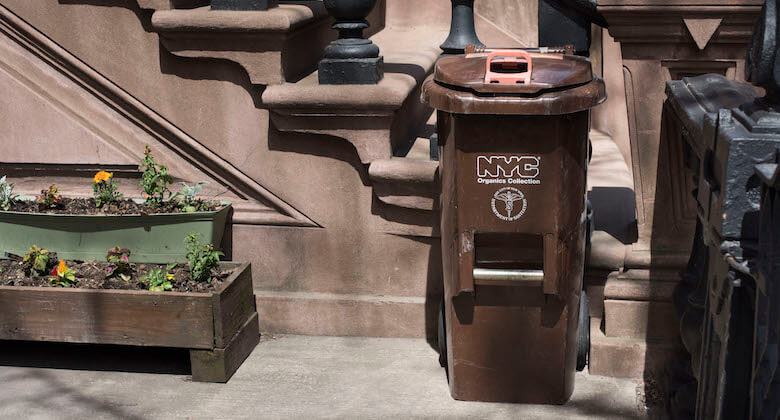
Editor’s note: This story originally ran on November 1, 2017. We’re resurfacing today with an update from the author:
“After seven months of rallying neighbors and sending countless emails, my building finally and definitively told me they would not be enrolling in the city’s free organics pickup program—citing vague logistics challenges and worries about rats (which apparently have opposable thumbs in Brooklyn). Some landlords, it seems, just cannot be won over. I’ll be looking forward to the city making this program mandatory in the near future, and until then, will continue to make regular trips to my closest Greenmarket.”
—
I clearly remember the moment I saw my first brown bin. It literally made me stop in my tracks. Sitting in front of a Williamsburg townhouse, it looked so cheery and natural next to the garbage and recycling containers that it seemed as though it had always been there. As I marveled at it, though, very quickly, my awe turned to jealousy. Why didn’t my building have organics pickup yet?
Since April this year, the city has rolled brown bins out to 2.5 million lucky New Yorkers in 17 Brooklyn, Bronx and Queens neighborhoods. All residential buildings in those places with nine or fewer units automatically received bins, while larger apartments can simply call or sign up online to get in on the action. Other neighborhoods—including the whole of Manhattan—are likewise eligible for organics collection services, if only they enroll.
The program is free to participate in, and city officials help with onsite training and set-up to ensure that, no matter how tricky the waste disposal situation, brown bins can be seamlessly incorporated. “There are single family homes and huge apartment buildings, buildings that are brand new and ones that are 100 years old—and everything in between,” says Belinda Mager, an NYC Department of Sanitation spokesperson. “We work with building managers, porters and residents to put together a program that works for them and their infrastructure.”
Over 30 percent of New York City’s garbage is of the organic variety—that is, food scraps, yard waste and compostable paper. When that material finds its way into a landfill rather than a compost facility, it doesn’t just sit there—it decomposes. But in a tightly packed, oxygen-deprived mountain of garbage, organic material undergoes anaerobic decomposition, the byproduct of which includes large amounts of methane rather than carbon dioxide. While both are greenhouse gases, methane can store about 25 times more heat than CO2, making it a much more potent environmental foe.
Given that, composting dovetails nicely into New York City’s plan to reduce greenhouse gas emissions by 80 percent by 2050. The practice also makes sense from an economic point of view: it turns waste into something useful and valuable—nutrient-rich soil—rather than something that costs money to ship and store in landfills.
“New York City has very ambitious, worthy goals for slashing the amount of waste sent to landfills, and one key element to achieving that is universal organics collection and composting,” says Eric Goldstein, a senior attorney and New York City environment director at the Natural Resources Defense Council. “We’re in the midst of a quiet revolution in waste handling.”
Participating in that revolution if your building still doesn’t have organics pickup in place, however, requires some effort. I’ve been a stringent composter since 2011—ever since an Edible Manhattan assignment opened my eyes to the ills of organic waste. But while I delight in visiting the farmers market to dutifully drop off my bags of frozen waste, on certain mornings—when there’s a snowstorm underway, or following a particularly productive Friday night out—these trips can be a slog.
On top of that, a several-month stint in compost-enlightened San Francisco—where organics recycling is just as mandatory as conventional recycling—opened my eyes to the fact that there is another way: compost collection can be a perk of city living.
Given all of this, I really wanted my Brooklyn building to sign up for the new organics pickup program. The first thing I did after my initial brown bin encounter was to confirm that my section of Williamsburg fell within the collection zone. Indeed, it did; I was jubilant.
Unfortunately, my building’s management did not share my enthusiasm. I live in the type of high-rise glass tower that markets itself as “luxury,” and although the owners describe themselves online as being “focused on providing superior service and responsiveness to all residents while working to increase the overall value of the asset,” my first compost-related email (and multiple follow-ups) went unanswered for two weeks. When the one-line reply finally came, it was not encouraging: “This program is only for a 1-9 unit building.”
Rather than give up, however, I was all the more determined to persevere in my compost quest—and to provide some valuable lessons for those who might find themselves in similar predicaments.
1. TALK IT OUT
To be clear, many landlords are 100 percent pro-composting and proactively enroll in the program. But for those who are more reluctant, simply addressing their concerns can often eliminate roadblocks. Frank Franciosi, executive director of the U.S. Composting Council, suggests cornering (or nicely approaching) organics-wary supers to ask them why they are hesitating. List down what they say and then either contact the city for help or provide the answers—many of which are available online—yourself. “A lot of obstacles can be overcome just by bringing them to a head,” Franciosi says.
2. CLEAR UP MISCONCEPTIONS
Andrew Hoyles, senior manager of organics outreach at the NYC Department of Sanitation, says that some of the most frequent landlord worries he encounters concern unwanted four-to-six-legged visitors. “In some parts of the city, people describe raccoons as tipping over the trash and getting in there and having a party with all their friends,” he says. “They’re afraid that, with the brown bins, the party will be even bigger.”
The brown bins, however, actually reduce opportunities for raccoon, rat and roach ragers, because they have locking lids specifically designed to prevent pests from getting in. As Mager points out, “Rats don’t have opposable thumbs.” Foul odors—another common landlord fear—is a non-issue as well, since compost is picked up regularly (plus it’s composed of material that would be in the building’s garbage anyway).
Many building managers also wrongfully assume that brown bins will create more work for them, but Hoyles counters that the goal is ultimately to make all waste disposal—recycling, landfill and organics—easier. When he and his colleagues make onsite visits, they work to figure out new ways to streamline everything. “It’s almost like a restart,” he says.
3. PERSIST
Two months after my initial query, my building’s restart still had not arrived. The first property manager had punted me off to another who told me that his team was “studying the program” and waiting to hear back from the Department of Sanitation. When he informed me, two weeks later, that Department had still had not replied, I reached out to the city myself to see what the hold-up was—only to learn that it was the manager and his colleagues who were the non-repliers to multiple emails and calls. Politely pointing out the “miscommunication” and cc’ing the city official I had been in touch with finally led to management scheduling a walk-though—three months after I sent that first email.
4. RALLY THE TROOPS
I am cautiously optimistic that my building will give composting the go-ahead following the city visit, but I am also ready to mobilize neighbors, should a little more encouragement be needed. There is power in numbers, Goldstein says, and a tenant petition can play a decisive role in convincing management that organics pickup is worthwhile.
Adds Mager: “We have a competitive housing market here, and managers know they need to keep residents happy.”
5. IMPLEMENT PLAN B
Of course, there is a chance that my building and others, for whatever reason, simply will not participate. But there are still workarounds. Some altruistic landlords take part in the city’s sharing program, allowing those with slacker supers to deposit organic scraps in certified neighboring bins. There’s also always the 100-plus GrowNYC and other organics drop-off sites scattered around the city, and do-it-yourself composting.
6. BE PATIENT
Around 90 percent of residential organics pickup services around the U.S. are implemented on a voluntary basis, and for now, New York is no exception. But eventually, reluctant landlords may no longer have a choice in the matter. Based on how cutting-edge programs in places like San Francisco and Seattle work, Goldstein suspects that officials here will eventually make the program mandatory. “There’s no reason to think that, over the next four to five years, composting won’t become a norm in waste handling here,” he says. “That’s where we are and need to be heading.”



